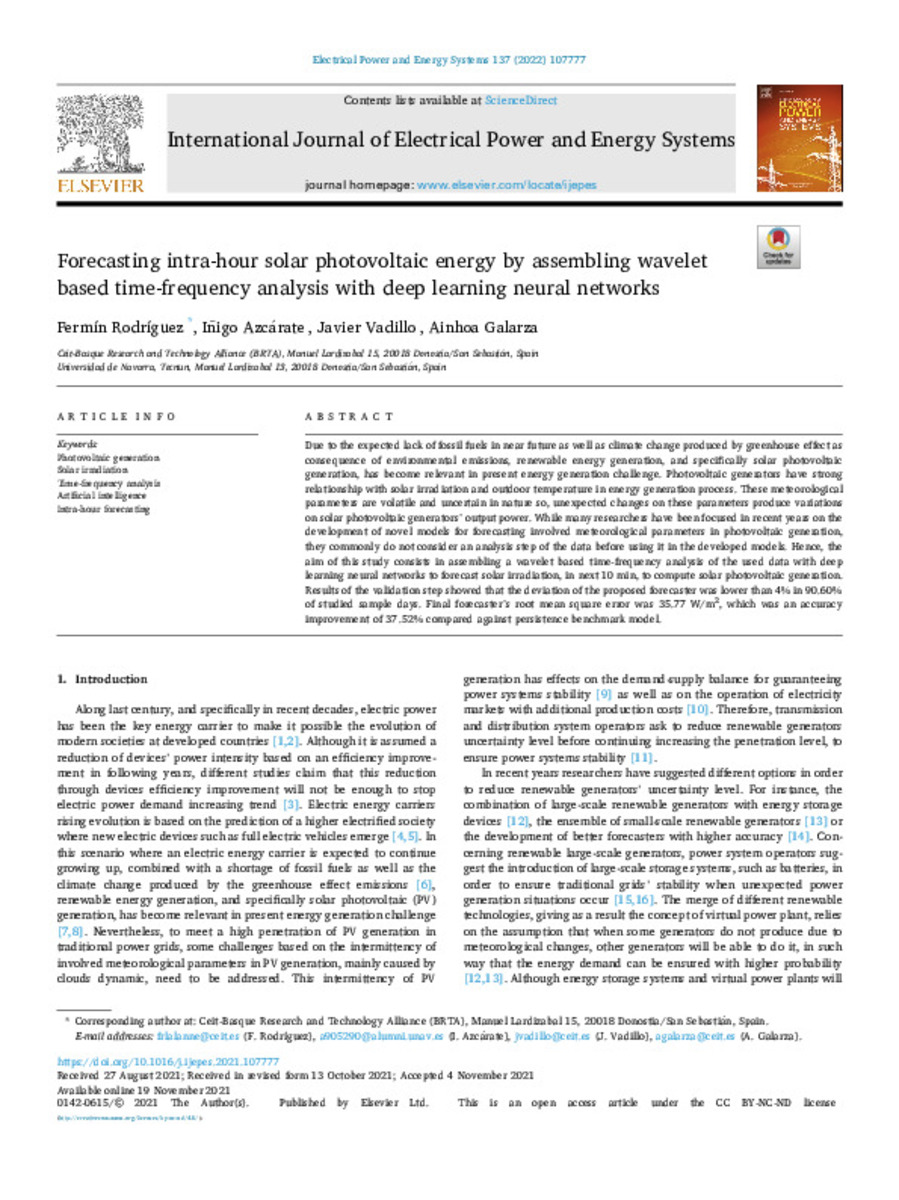Full metadata record
| DC Field | Value | Language |
|---|---|---|
| dc.creator | Rodríguez-Lalanne, F. (Fermín) | - |
| dc.creator | Izal-Azcárate, I. (Íñigo) | - |
| dc.creator | Vadillo, J. (Javier) | - |
| dc.creator | Galarza-Rodríguez, A. (Ainhoa) | - |
| dc.date.accessioned | 2022-05-31T09:48:48Z | - |
| dc.date.available | 2022-05-31T09:48:48Z | - |
| dc.date.issued | 2022 | - |
| dc.identifier.citation | Rodríguez-Lalanne, F. (Fermín); Izal-Azcárate, I. (Íñigo); Vadillo, J. (Javier); et al. "Forecasting intra-hour solar photovoltaic energy by assembling wavelet based time-frequency analysis with deep learning neural networks". International Journal of Electrical Power & Energy Systems. (137), 2022, 107777 | es |
| dc.identifier.issn | 0142-0615 | - |
| dc.identifier.uri | https://hdl.handle.net/10171/63582 | - |
| dc.description.abstract | Due to the expected lack of fossil fuels in near future as well as climate change produced by greenhouse effect as consequence of environmental emissions, renewable energy generation, and specifically solar photovoltaic generation, has become relevant in present energy generation challenge. Photovoltaic generators have strong relationship with solar irradiation and outdoor temperature in energy generation process. These meteorological parameters are volatile and uncertain in nature so, unexpected changes on these parameters produce variations on solar photovoltaic generators’ output power. While many researchers have been focused in recent years on the development of novel models for forecasting involved meteorological parameters in photovoltaic generation, they commonly do not consider an analysis step of the data before using it in the developed models. Hence, the aim of this study consists in assembling a wavelet based time-frequency analysis of the used data with deep learning neural networks to forecast solar irradiation, in next 10 min, to compute solar photovoltaic generation. Results of the validation step showed that the deviation of the proposed forecaster was lower than 4% in 90.60% of studied sample days. Final forecaster’s root mean square error was 35.77 W/m2, which was an accuracy improvement of 37.52% compared against persistence benchmark model | es_ES |
| dc.description.sponsorship | The authors would like to thank the Basque Government’s Department of Education for financial support through the Researcher Formation Programme; grant number PRE_2020_2_0038. | es_ES |
| dc.language.iso | eng | es_ES |
| dc.publisher | Elsevier | es_ES |
| dc.rights | info:eu-repo/semantics/openAccess | es_ES |
| dc.subject | Photovoltaic generation | es_ES |
| dc.subject | Solar irradiation | es_ES |
| dc.subject | Time-frequency analysis | es_ES |
| dc.subject | Artificial intelligence | es_ES |
| dc.subject | Intra-hour forecasting | es_ES |
| dc.title | Forecasting intra-hour solar photovoltaic energy by assembling wavelet based time-frequency analysis with deep learning neural networks | es_ES |
| dc.type | info:eu-repo/semantics/article | es_ES |
| dc.description.note | This is an open access article under the CC BY-NC-ND license | es_ES |
| dc.identifier.doi | 10.1016/j.ijepes.2021.107777 | - |
| dadun.citation.number | 137 | es_ES |
| dadun.citation.publicationName | International Journal of Electrical Power & Energy Systems | es_ES |
| dadun.citation.startingPage | 107777 | es_ES |
Files in This Item:
Statistics and impact
Items in Dadun are protected by copyright, with all rights reserved, unless otherwise indicated.






